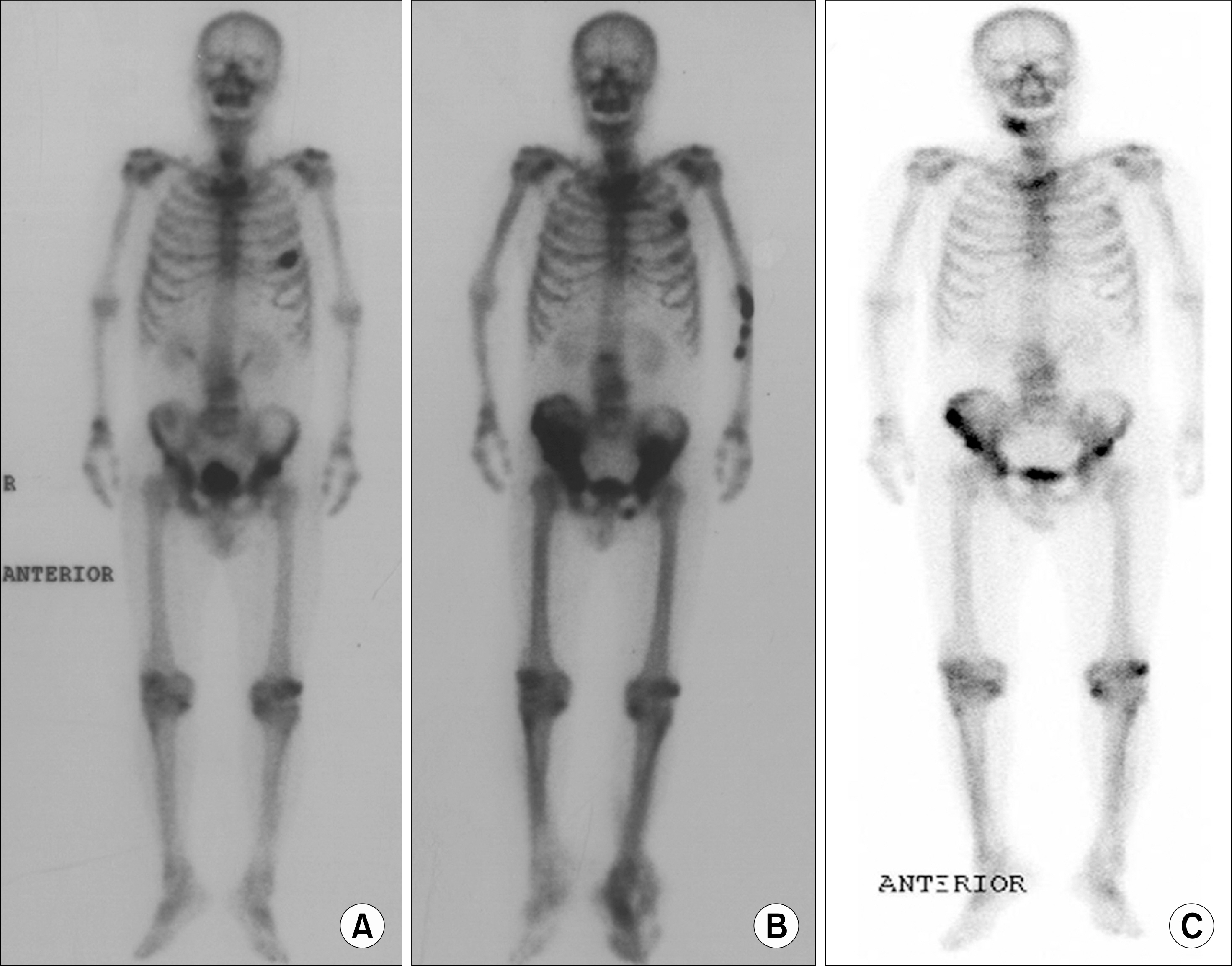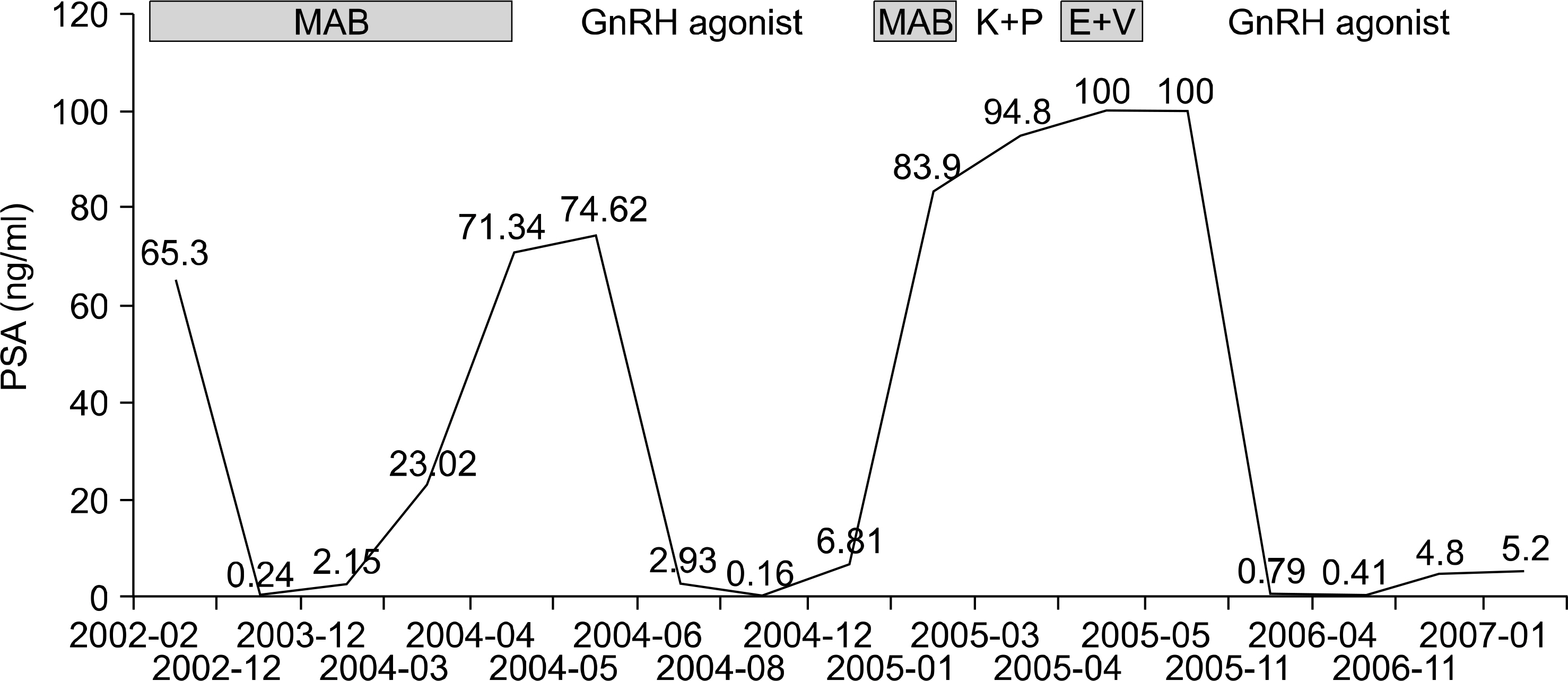Korean J Urol.
2007 Jul;48(7):751-753. 10.4111/kju.2007.48.7.751.
Dramatic Decline of PSA and Symptom Improvement after Estramustine Withdrawal in a Hormone-refractory Prostate Cancer Patient
- Affiliations
-
- 1Department of Urology, College of Medicine, Dongguk University, Gyeongju, Korea. ksleemd@dongguk.ac.kr
- KMID: 1990230
- DOI: http://doi.org/10.4111/kju.2007.48.7.751
Abstract
- In some patients with prostate cancer and who manifest disease progression during maximal androgen blockade(MAB) therapy, discontinuation of antiandrogen treatment might result in a significant fall in the level of serum prostate-specific antigen(PSA), and this is often correlated with clinical improvement(antiandrogen withdrawal syndrome). However, a decline in the PSA level after the withdrawal of estramustine phosphate is extremely rare. We report here on a case of dramatic decline in the PSA level after withdrawal of estramustine phosphate in a patient with hormone refractory prostate cancer.
Keyword
MeSH Terms
Figure
Reference
-
References
1. Kelly WK, Scher HI. Prostate-specific antigen decline after antiandrogen withdrawal: the flutamide withdrawal syndrome. J Urol. 1993; 149:607–9.2. Nishiyama T, Terunuma M. Hormone/antihormone withdrawal and dexamethasone for hormone-refractory prostate cancer. Int J Urol. 1998; 5:44–7.
Article3. Shibata Y, Morita T, Kashiwagi B, Tomizawa H, Yamanaka H. Estramustine phosphate withdrawal syndrome with dramatic pain relief. J Urol. 1999; 162:805.
Article4. Kobayashi M, Kuramoto H, Ota J, Fujimoto N. Dramatic decline in prostate-specific antigen by withdrawal of estramustine phosphate in hormone refractory prostate cancer. Int J Urol. 2006; 13:1019–21.
Article5. Miyamoto H, Rahman MM, Chang C. Molecular basis for the antiandrogen withdrawal syndrome. J Cell Biochem. 2004; 91:3–12.
Article6. Suzuki H, Akakura K, Komiya A, Aida S, Akimoto S, Shimazaki J. Codon 877 mutation in the androgen receptor gene in advanced prostate cancer: relation to antiandrogen withdrawal syndrome. Prostate. 1996; 29:153–8.
Article7. Gottlieb B, Lehvaslaiho H, Beitel LK, Lumbroso R, Pinsky L, Trifiro M. The androgen receptor gene mutations database. Nucleic Acids Res. 1998; 26:234–8.
Article8. Hudes G, Einhorn L, Ross E, Balsham A, Loehrer P, Ramsey H, et al. Vinblastine versus vinblastine plus oral estramustine phosphate for patients with hormone-refractory prostate cancer: A Hoosier Oncology Group and Fox Chase Network phase III trial. J Clin Oncol. 1999; 17:3160–6.
Article
- Full Text Links
- Actions
-
Cited
- CITED
-
- Close
- Share
- Similar articles
-
- Estramustine Phosphate Based Chemotherapy for Hormone Refractory Prostate Cancer
- Comparison of Ketoconazole and Estramustine for Treating Patients with Castration-Resistant Prostate Cancer
- Long-Lasting Antiandrogen Withdrawal Syndrome in Castration-Resistant Prostate Cancer: Three Cases With Complete Response
- Prostate-Specific Antigen Nadir and Time to Prostate-Specific Antigen Nadir Following Maximal Androgen Blockade Independently Predict Prognosis in Patients with Metastatic Prostate Cancer
- Free PSA and the Free PSA to Total PSA Ratio as a Predictor of Response to Hormone Treatment for Metastatic Prostate Cancer



